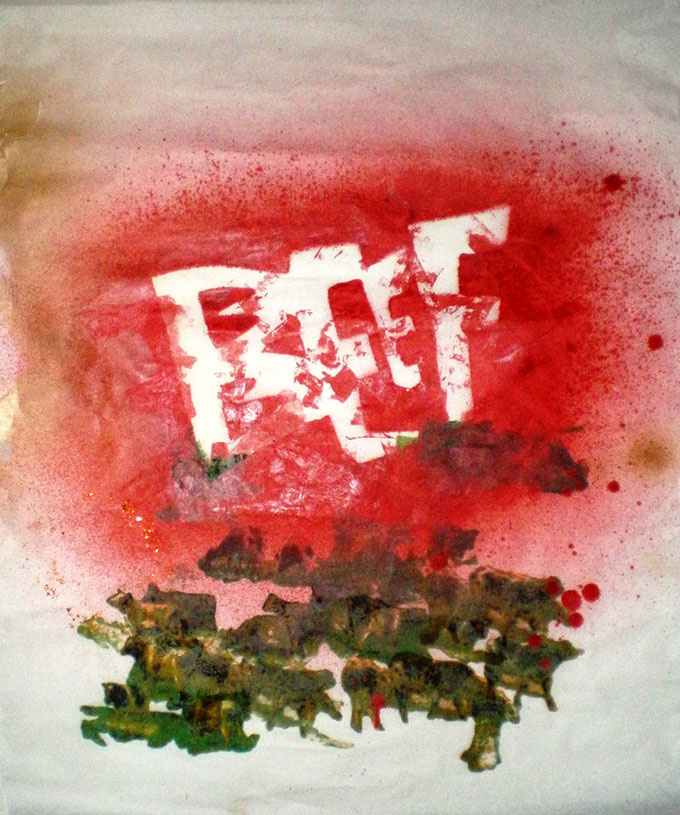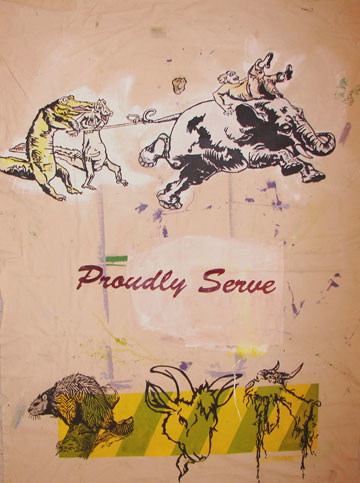Ne Plus Ultra: Michael Beam's Retrospective at Big Orbit Gallery
by Jack Foran

In Concept
The first thing that caught my eye when I entered the Michael Beam ten-year retrospective exhibit at Big Orbit Gallery was a crudely hand-painted sign, red paint on white poster cardboard, recommending “Eat at Lone Star.” Because I’d seen that sign before, or one just like it, in my neighborhood. On the street somewhere. A sort of unsanctioned advertisement. Up until somebody takes it down, or it deteriorates and disappears. And sure enough, the descriptive note for the piece explained that it was “found April 1, 2013, in the 800 block of Hertel Avenue, road-side.” My thought—my regret—when I saw it in the exhibit, was that I had missed my chance, I could have been an artist. If it had only occurred to me to appropriate the thing, take it home.
Michael Beam’s artwork asks questions about art. Like what is art? Questions, however, it seems, sometimes beyond or outside the intentionality of the artist. For example, with regard to the Lone Star sign, what is art? But then the further question, what is the point? Beam’s work is in the category conceptual art, but the concept or concepts seem to take over, and run amuck. Go out of control.
When Marcel Duchamp exhibited a urinal as an artwork, he was inventing conceptual art. He was saying, art is art because I am an artist and I say it is, and I am an artist because I have just created art. In that case, that was the point. That statement. The Lone Star sign, as an artwork, reiterates that statement. But the reiteration loses some of the force of the statement. It becomes a little tired.

Another work or series consists of mock replicas of a famous actual diamond known as The Regent—weighing in at just over 140 carats, the gargantuan gem has made its rounds of monarchical crowns and sword hilts, and is now in the Louvre—out of what is described as a “gelatinous mass of coagulated cheese ‘powdercoating.’” Looks a little like the wax overcoat usually on Gouda, only bright orange instead of bright red. Carrot color, actually. Maybe that’s the point, the pun. Otherwise, I wonder, what is the point?
Hermetic is a theme. Art as mysterious. So if you don’t get it, that makes it art. A little like Duchamp’s saying the urinal is art because he is an artist and says it is art, though less likely ultimately to persuade. One work is a sealed wooden shipping box said to contain a variety of art and art-related items Beam has collected over the past some years, such as a Hostess Twinkie vacuum-sealed in plastic wrap. (An accompanying catalog names the items in the box, rather vitiating even the hermetic idea. So what is the point of the sealed box?)

Sometimes the presentation makes a complex artistic matter unnecessarily much more difficult. For example, in the case of one anomalously cogent and coherent work, as well as richly comic, consisting of nineteenth-century master painter Frederic Church’s spectacular depiction of Niagara Falls—a copy, let’s hope—obscured almost entirely by a dense overlay of dark red-brown paint apparently poured over it, and the text lament in white letters on the red-brown: “I can’t paint like I used to.” Only a little bit of the Frederic Church painting is still legible, a strip along the bottom the red-brown paint doesn’t cover, but just drips down onto. The piece caption reads: “Precession HOMEDEPOT Low-VOC Spectrophotometer matched to Frederic Church’s 1857 painting...” Read on into the fine print and you discover the red-brown paint was “Precision matched by Home Depot using a Low-VOC Line Spectrophotometer” to a circled small area of the Church painting. Garble then correction, but more information than we need, twice over. Double distraction from the conceptual artistic meaning of the work.
Among the plethora of found objects and general bizarrerie are a few of the artist’s paintings/drawings, featuring odd but intriguing juxtapositions of imagery. A rabbit out of a hat, a galloping herd of donkeys, the superstructure of a battleship, a government capital building dome, and sheepish-looking figure, a possible self-portrait. But puzzles that seem worth puzzling out. I would have liked to have seen more of such work in the show. The artist’s own artwork, and more than mere concept.
The exhibit continues until December 20.
blog comments powered by Disqus
|
Issue Navigation> Issue Index > v13n48 (Gift Guide, Week of Thursday, November 27) > Ne Plus Ultra: Michael Beam's Retrospective at Big Orbit Gallery This Week's Issue • Artvoice Daily • Artvoice TV • Events Calendar • Classifieds |









 Current Issue
Current Issue